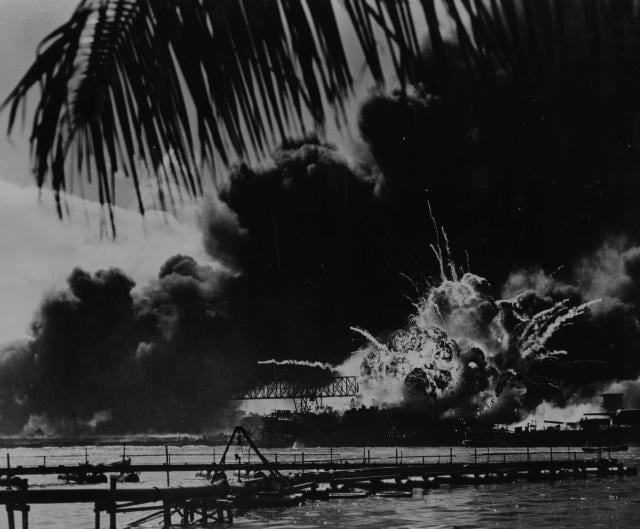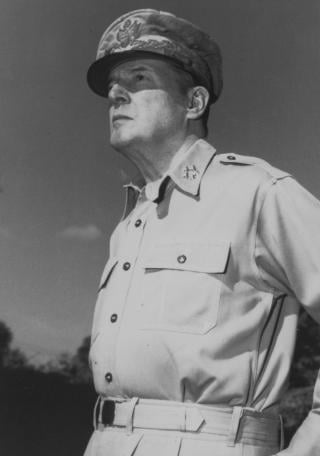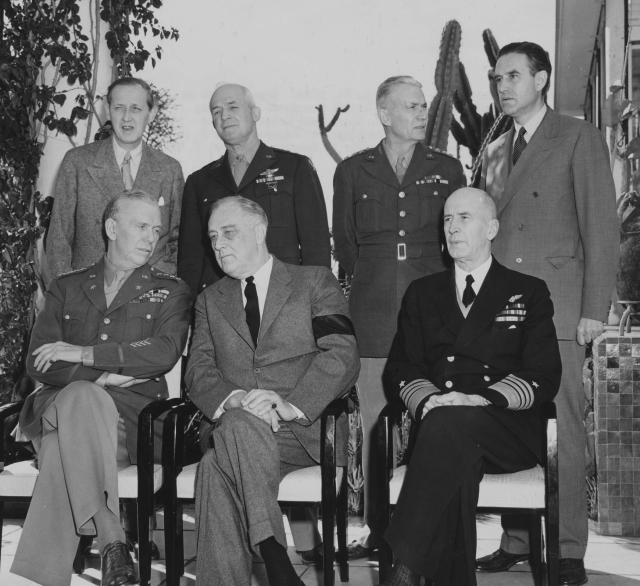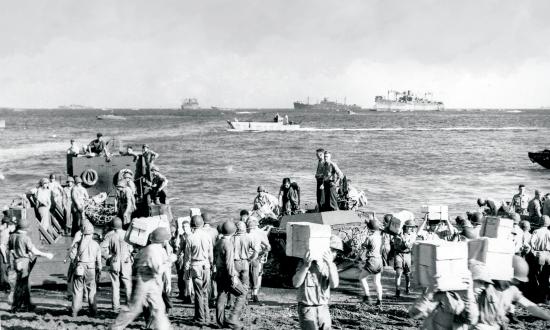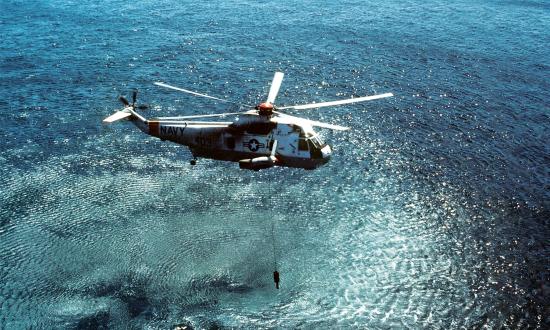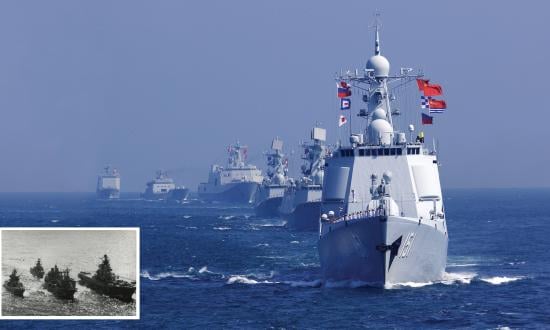The occupation and hardening of islands in the South China Sea by the People’s Republic of China looks remarkably similar to the actions of the Empire of Japan in World War II. In the event of large-scale combat operations, the United States will need to develop an effective strategy to address the antiaccess/area denial (A2/AD) perimeter China is employing off its coast. This stand-off corridor will present immense challenges if the US intends to conduct any type of joint forcible entry operation from the sea into the Chinese mainland. As such, it is worth examining the Allied strategy against Japan for any concepts that can be emulated.
By understanding the evolution of the strategy in the Pacific and the results of the Allied efforts there, the Navy and the Joint Force can forge a future approach and learn important lessons in the event the United States finds itself executing large-scale combat operations against China. These include the creation of a coordinated strategy, the importance of the total Joint Force and U.S. allies, amphibious operations, and theater logistics.
The evolution of the war in the Pacific against Japan is generally considered to consist of four phases: defense, defense-offense, offense-defense, and offense.1 The operational and tactical realities in each of these phases resulted in the development of different strategies by senior civilian and military Allied leaders during a series of top-secret and code-named planning conferences from 1941 to 1945.
The Defensive Phase
The surprise and destruction wrought on the Pacific Fleet at Pearl Harbor caught the United States completely off guard. As such, the initial strategy adopted by the United States was defensive. It focused on defending its Pacific shores and its line of communications to U.S. holdings and allies in the region.2 This phase lasted from Pearl Harbor until the battle of the Coral Sea in May 1942—where the first major Japanese attack in the war was halted. The major Allied meetings that occurred during this phase to determine the strategy to counter Japan were codenamed Arcadia and Post-Arcadia.
(U.S. Naval Institute Photo Archive)
By January 1942, the Combined Joint and Allied Chiefs of Staff had realized it was crucial to halt the enemy’s advance across the Pacific region as soon as possible.3 “With the losses we have sustained, it is necessary to revise completely our strategy,” noted Commander of the U.S. Pacific Fleet Admiral Chester Nimitz to the senior leaders at Post-Arcadia.4 Most present agreed with Nimitz and grudgingly recognized Japanese dominance and acknowledged that the situation was grave.5 They also noted that it would only be through great energy, skill, and determination could the United States halt Japan’s expansion before it attained a dominate position where it could not be ejected.6
The attack on Pearl Harbor and the loss of several battleships left the United States strategically unable to immediately respond. As early as 10 December 1941 Nimitz accurately summarized the current strategic situation undertaken by the Unites States and its allies during this phase: “The loss of battleships commits us to the strategic defensive until our forces again can be built up.”7 Despite calling for a defensive posture, Nimitz also realized that the United States was not toothless; it still possessed carriers, cruisers, and destroyers that could be marshaled immediately “to retrieve our initial disaster.”8 This purely defensive phase culminated in the Battle of the Coral Sea in May 1942, where the Japanese Navy was successful fought to a tactical standstill—a first for the war.
The Defensive–Offensive Phase
Shortly after the Battle of the Coral Sea, the United States embarked on an offensive operation that culminated in the Battle of Midway in June 1942. There, the United States blunted the Japanese advance into the Pacific by delivering a decisive blow that crippled the Imperial Japanese Navy Fleet, halted its expansion, and forced it on the defense for the rest of the war. By mid-1942, the Allies had generally agreed that the defeat of Germany would be the main effort; however, pressure (led by the United States) would be maintained against Japan to regain the initiative and prevent its further extension further the region.9 Despite this Germany first mindset, Midway gave the United States—though still on the defense itself—some space to plan and implement a more aggressive offensive strategy for the region.10
(U.S. Naval Institute Photo Archive)
“The whole course of the war in the Pacific may hinge on the developments of the next two or three days,” correctly predicted the daily action log for the U.S. Pacific Fleet just prior to Midway.11 With the outcome all but set, this same log soon correctly recorded that the victory virtually ended Japanese expansion into the Pacific.12 Nimitz himself proclaimed to the American public that Pearl Harbor was partially avenged but would not be complete until Japan had been reduced to impotence. Tongue in cheek, he concluded “perhaps we will be forgiven if we claim we are about midway to our objective."13
This newfound aggressiveness and optimism now also was observed in other American commanders. General Douglas MacArthur, Supreme Commander of Allied Forces in the Southwest Pacific Area, radioed the Army Chief of Staff to say that Midway had changed the strategic situation which must be exploited through offensive action.14 Midway ultimately signaled the transition from defense to a new and important phase in the US strategy to counter Japan.
The Offensive–Defensive Phase
With Midway, the United States seized the initiative and for the first time was able to aggressively plan offensive operations. Despite this, it had not achieved full freedom of maneuver and still had to use a large portion of its force to consolidate its gains and defend large-scale combat operations.15 This phase lasted from August 1942 to August 1943 and is most remembered for the offensive operations related to Guadalcanal. The major Allied meetings that occurred during this phase were codenamed Casablanca, Trident, and Quadrant.
By the Casablanca Conference in early 1943, the allies had concluded that the goal was to conclude the war as early as possible. It was determined that the Axis’ economic and military strength must be destroyed at a rate that exceeded their ability to replace.16 To achieve this in the Pacific, Joint and Allied planners realized it would require the enemy to be kept under a constant pressure powerful enough to absorb all Japan’s military efforts.17 As such, strategic objectives were defined: halt further expansion; prevent Japan from consolidating its remaining positions; protect existing and opening new large-scale combat operations to the Allies while menacing Japan’s; and, finally, intensify the attrition of the enemy by land, air, and sea.18
Accomplishing these objectives in the Pacific was no easy task. Allied large-scale combat operations extended more than 12,000 miles—from the Bering Sea, through the Hawaiian Islands, Samoa, Fiji, New Guinea, and Northwest Australia, to Singapore. In contrast, the Japanese occupied strongly established interior lines, which permitted them to react quickly to Allied offensives with an economy of force.19 To counter this, it was decided to simultaneously strike at points deemed significant to Japan cause it to react, whereby it was hoped that the overwhelming firepower of the Joint Force would destroy its military forces. Presenting multiple dilemmas would prevent Japan from consolidating its gains and hardening its island holdings and preclude it from initiating any offensive operations.20 This technique would give birth to the most important and least understood strategy of the Pacific Theater.
As noted by MacArthur, once the Allies undertook the offensive, all ground, air, and sea operations became mutually supportive and “thoroughly coordinated.” He dubbed this a new type of campaign, calling it “three-dimensional warfare” and a “triphibious concept.”21 What soon became known as island-hopping or leapfrogging is sometimes misunderstood as frontal attacks on heavily fortified island positions; in fact, this was not the strategic concept. Rather, as MacArthur recognized, it was a unique system of warfare for the Pacific: avoid the frontal attack, bypass island strong points, and then isolate and cut off their lines of supply.22 Or, as Admiral William (Bull) Halsey described it, “Jump over the enemy’s strong points, blockade them, and leave them to starve.”23
In addition to bypassing and blockading enemy strong points, some islands in the Pacific were seized. The Joint Force would then use these locations to solidify its large-scale combat operations, create power projection platforms, and more importantly, build airfields to provide air cover for the next offensive. As MacArthur noted, “Every step forward had been governed by the basic concept of securing airfields no more than 200 to 300 miles apart from which to assure an ‘air umbrella’ over each progressive thrust into the enemy.”24 The end goal for these island air bases was to eventually work toward positions from which the Japanese homeland could be attacked by land-based air.25
Despite the effectiveness of this technique, at the Casablanca Conference, senior leaders quickly realized that leapfrogging alone would take too long and not be the winning strategy for the Pacific.26 As such, other methods of attrition needed to be determined. One way to accomplish this was to continue the intensified attacks on enemy shipping to disrupt the enemy’s large-scale combat operations between Japan and its territorial holdings.27]The second method was to put direct pressure on these same positions. It was during this phase that planning began for the Allied attack into Burma and support for Chinese forces under Chiang Kai-shek intensified.28 As Roosevelt declared at Casablanca, it was believed that with the inability to move freely along Pacific large-scale combat operations, combined with pressure on its territories, “Japan would be hard pressed to maintain her garrison in the chain of islands stretching all the way from Burma to New Guinea and would have to start pulling in her lines.”29
The strategic objectives during the offensive-defensive phase set the conditions for the United States and its allies to conduct the final phase of their strategy. “We must not allow the Japanese any pause,” declared General George Marshall at Casablanca; “the only way of stopping the Japanese was by complete exhaustion through attrition. It was very difficult to pause,” he continued, “the process of whittling away Japan had to be continuous.”30
(U.S. Naval Institute Photo Archive)
The Final Offensive Phase
By late 1943, the United States and the Allies found themselves in a position in which their advance bases and large-scale combat operations were no longer seriously threatened. They now attained the freedom of maneuver to conduct offensive operations at the times and locations of their choosing.31 This final phase would culminate with the dropping of the atomic bomb and Japan’s unconditional surrender. The major Allied meetings that occurred during this phase were codenamed Sexton, Eureka, Octagon, Argonaut, and Terminal (Potsdam).
US and Allied planners were unaware of the atomic bomb until late July 1945. As such, it was not initially considered in the strategy for this phase. By the end of 1943, a two-pronged assault was being executed, with Nimitz applying pressure in the central Pacific and MacArthur in the south. Strategic objectives were to maintain large-scale combat operations, force continued attrition, contain the Japanese fleet, keep Pacific Allies in the war, and, finally, attain positions for a full-scale offense against the Japanese homeland.32
These offensives in the Pacific, combined with actions in Burma and China, were successful in staging the Joint Force and its allies for this invasion. By late July 1945, the Japanese home islands were isolated via sea and air blockades. Intensive air bombardments had wreaked havoc on civilian and economic targets, and her military had been eroded to a skeleton force.33 Because of this posture, President Harry Truman issued an ultimatum to Japan that as long as its leaders continued to support the war, that country would be utterly destroyed.34 Truman professed that U.S. efforts would not cease “until the Japanese military and naval forces lay down their arms in unconditional surrender.”35
Despite its degraded condition, the final invasion of Japan still presented a challenge. It was estimated that some two million men of fighting stock were still available who would fanatically defend their homes.36 In a moment of premonition in 1941, Japanese antiwar protagonist Baron Wakatsuki Reijiro accurately predicted to the Emperor that by wars’ end the nation would face ultimate defeat and be reduced to ashes.37 With the dropping of the atomic bombs in early August 1945, this portent would be realized as Japan unconditionally surrendered.
Results of the U.S. Strategy and the Atomic Bomb
In the final Allied planning conference of the war, it was recognized that the island-hopping campaign had provided the Allies with forward air bases that could strike enemy forces anywhere. In addition, it gave them advanced power projection platforms to invade the Japanese home islands if needed.38 Numerous strong points in the Pacific had been isolated and rendered ineffective; crucially, almost 300,000 Japanese troops were stranded.39
Allies and enemies alike commented on the brilliance of this U.S. strategy. In his diary, the Chairman of the British Chief of Staff noted the masterly manner in which the United States jumped from island to island, leaving masses of Japanese to decay behind them.40 After the war, a senior Japanese intelligence officer commented on the strategy’s effectiveness, praising it “for its brilliance because it gained the most while losing the least.”41 A Japanese fleet Ccommander declared after the war that what had pained them the most was the land-based air force stationed on forward islands.42 Halsey declared the island-hopping strategy to be what won the war in the South Pacific.43
(U.S. Naval Institute Photo Archive)
As later noted by Allied planners, the unrelenting joint all domain attacks on Japanese large-scale combat operations and the relentless attrition of their military destroyed Japanese naval and air forces and reduced them to desperate ploys like suicide attacks.44 “The stress laid upon rear areas is quite considerable,” noted an instructional circular distributed to Japanese forces that commented on the impact of attacks on large-scale combat operations, “this is to say, the enemy is constantly attacking our transport ships rather than our warships.”45 By early July 1945, Allied planners concluded that due to the blockade and relentless air campaigns, Japan was ripe for invasion. This final offensive was, of course, avoided by the events of 6 and 9 August 1945.46
Many credit the bomb as ending the war in Japan. However, this was but one piece of the complete strategic puzzle in the Pacific. “It would be a mistake to suppose that the fate of Japan was settled by the atomic bomb,” remarked British Prime Minister Winston Churchill after the war. In his memoirs, he accurately reminded the public that it was seizing ocean bases through conventional means that allowed the Allies to get close enough to launch the planes that delivered their atomic payloads.47 Halsey echoed this sentiment, arguing that the belief that the bomb ended the war was overvalued. In a testament to the successful drive across the Pacific, it was his hope history would remember that when hostilities ended, “the capital of the Japanese Empire had just been bombed, strafed, and rocketed by planes of the Third Fleet, and was about to be bombed, strafed and rocketed again.”48
Lessons for Large-Scale Combat Operations Against China in the Pacific
The Pacific theater strategy during World War II offers four major lessons for the Navy and the Joint Force. First, the conflict highlights the importance of establishing a coordinated joint strategy in the event of current large-scale combat operations with China. Interestingly, the Navy noted after the war that when planning for future contingencies you cannot separate naval, air, and ground strategies.49 Unlike that which occurred in 1941, the United States must avoid the purely defensive phase that surrenders the initiative to the enemy—the adopted strategy should be joint and one that can quickly pivot to the offense as soon as possible.
Second, as MacArthur witnessed in the Pacific, “Never before had a field of battle embraced land and water in such relative proportions.”50 This same observation holds true with China: to counter these distances Joint, interorganizational, and allies must be leveraged. Like the strategy against Japan, applying pressure from all sides to China will involve intense diplomatic efforts and support from regional allies. This same seamless effort will hold true in the South China Sea and must be recognized now by the Joint Force.
Third, actions in the South China Sea and a joint forcible entry from the ocean will be amphibious in nature. The Joint Force should avoid finding itself in the same situation as 1943, where it lacked any kind of robust amphibious capabilities.51 As was also noted, these operations must be organized into proper joint assault formations that possess a degree of coherence and permanence.52 They cannot be ad hoc organizations pieced together with little to no prior training experience with one another. This is a core mission for the U.S. Marine Corps, which it has taken to heart; however, the Army also must be able to execute this function.53
Finally, as Lieutenant General Jack Fuson, a past Army Deputy Chief of Staff for Logistics, noted in his memoirs after his time in the Pacific, one can have the worlds’ best trained and equipped force but if it cannot be transported into enemy territory it is useless.54 The Marine Corps’ focus is to establish beachheads; it will be the Army’s role to expand and consolidate that lodgment for follow-on operations. “After landing at the target area,” Fuson wrote of island-hopping, “the Army then had to move in and establish a line of communication to sustain combat operations as far inland as necessary.”55 It will be the Army that will expand lodgments, form base camps and logistics hubs, secure airfields, and establish large medical facilities.
Some may argue that current efforts in hypersonic missiles, nuclear weapons, cyber, and long-range precision fires as negating any need to conduct joint forced entry operations into China. However, the Pacific war (and numerous others) demonstrated that technology and deep strikes alone are not the single deciding factor in large-scale combat operations. As was achieved with Japan, breaking the military and civilian will of a peer competitor and forcing them into political discussions is accomplished through a combination of attrition and constant pressure executed by the Joint Force with support from international allies.
1. Ernest J. King, Our Navy at War: Official Report Covering Combat Operations up to 1 March 1944 (Washington, DC: Secretary of the Navy, 1944), 25.
2. King, Our Navy at War, 25.
3. World War II Inter-Allied Conferences, Post-Arcadia, January 1941 to May 1942, Papers and Minutes of Meetings (Washington, DC: Joint History Office, 2013), 31.
4. ADM Chester W. Nimitz, USN, “Gray Book”: War Plans and Files of the Commander in Chief, Pacific Fleet, Vol. 1: 7 December 1941–1 September 1942, American Naval Records Society, 1.
5. Post-Arcadia, 79-80.
6. Post-Arcadia
7. Nimitz “Gray Book”,1.
8. Nimitz., 1:
9. World War II Inter-Allied Conferences, Casablanca Conference, January 1943, Papers and Minutes of Meetings (Washington, DC: Joint History Office, 2013), 84.
10. King, Our Navy at War, 25.
11. Nimitz, “Gray Book”, 574.
12. Nimitz, 575.
13. Chester Nimitz, June 6, 1942 Communique to the Press, World War II: The Allied Counteroffensive 1942–1945, The New York Times Living History, ed. Douglas Brinkley and David Rubel (New York, NY: Times Books, 2003), 4.
14. George Marshall Radio No. 204, June 10, 1942 to Douglas MacArthur, George C. Marshall Foundation.
15. King, Our Navy at War, 25.
16. Casablanca Conference, 4.
17. Casablanca Conference, 5.
18. Casablanca Conference, 95–96.
19. Casablanca Conference, 5.
20. Casablanca Conference, 5–6.
21. Douglas MacArthur, Reminisce.nces (Annapolis, MD: Bluejacket Books, 1964), 169.
22. MacArthur, Reminiscences, 169.
23. William F. Halsey and J. Bryan III, Admiral Halsey’s Story (New York, NY: Curtis Publishing Company, 1947), 170–71.
24. MacArthur, Reminiscences, 235.
25. Casablanca Conference, 95.
26. Casablanca Conference, 167.
27. Casablanca Conference, 95.
28. Casablanca Conference, 180.
29. Casablanca Conference, 167.
30. Casablanca Conference, 190.
31. King, Our Navy at War, 25.
32. World War II Inter-Allied Conferences, Trident Conference, May 1943, Papers and Minutes of Meetings (Washington, DC: Joint History Office, 2013), 28.
33. World War II Inter-Allied Conferences, Terminal (Potsdam) Conference, July-Aug 1945, Papers and Minutes of Meetings (Washington, DC: Joint History Office, 2013), 82-83.
34. Harry S. Truman, Public Papers of the President of the United States, Harry S. Truman, Containing the Public Messages, Speeches, and Statements of the President, 1945 (Washington, DC: Government Printing Office, 1961), 50.
35. Truman, Public Papers of the President of the United States, 50.
36. Terminal (Potsdam) Conference, 15.
37. Recorded in Diary of Marquis Koichi Kido, entry for 29 November 1941, found in The Pacific War Papers: Japanese Documents of World War II, ed. Donald M. Goldstein and Katherine V. Dillon, (Washington, DC: Potomac Books, 2004), 133.
38. Terminal (Potsdam) Conference, 12.
39. Terminal (Potsdam) Conference, 40.
40. Field Marshall Viscount Alanbrooke Diary found in Douglas MacArthur, Reminiscences (Annapolis, MD: Bluejacket Books, 1964), 311.
41. Col Matsuichi Juio’s comments found in Douglas MacArthur, Reminiscences (Annapolis, MD: Bluejacket Books, 1964), 170.
42. Recorded in Some Opinions Concerning the War from Admiral Nobutake Kondo, found in The Pacific War Papers: Japanese Documents of World War II, ed. Donald M. Goldstein and Katherine V. Dillon, (Washington, DC: Potomac Books, 2004), 314.
43. Halsey and J. Bryan III, Admiral Halsey’s Story, 172.
44. Terminal (Potsdam) Conference, 12.
45. A Japanese Analysis of American Combat Methods on Guadalcanal, found in John Miller, United States Army in World War II, The War in the Pacific, Guadalcanal: The First Offensive (Washington, DC: Center of Military History, 2006), 368.
46. Terminal (Potsdam) Conference, 19.
47. Winston Churchill, The Second World War: Triumph and Tragedy (Boston, MA: Houghton Mifflin Company, 1953), 646.
48. Halsey and J. Bryan III, Admiral Halsey’s Story, 271.
49. Forrest P. Sherman, Lecture: The Navy in World War II, found in Nimitz “Gray Book”: War Plans and Files of the Commander in Chief, Pacific Fleet, Vol. 7: 1 July 1945 - 31 August 1945, American Naval Records Society, 11.
50. MacArthur, Reminiscences, 169.
51. Jack C. Fuson, Transportation and Logistics: One Man’s Story (Washington, DC: Center of Military History, 1994), 18.
52. Casablanca Conference, 304.
53. Megan Eckstein, “New Marine Corps Cuts Will Slash All Tanks, Many Heavy Weapons As Focus Shifts to Lighter, Littoral Forces,” USNI News, 23 March 2020.
54. Jack C. Fuson, Transportation and Logistics: One Man’s Story (Washington, DC: Center of Military History, 1994), 5.
55. Fuson, Transportation and Logistics, 6.




